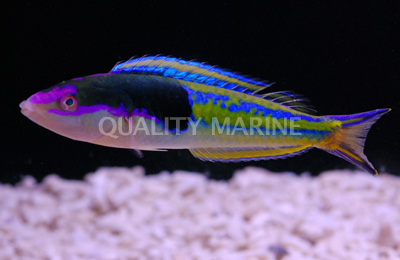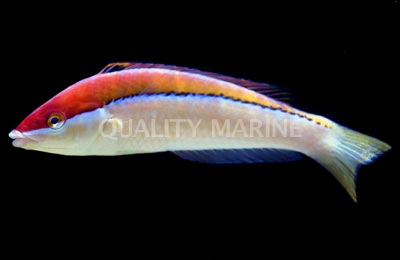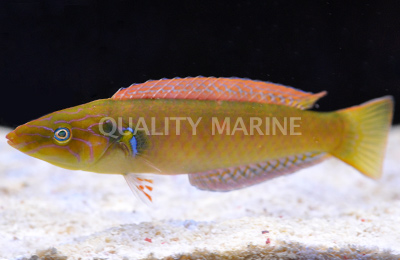Grab a Pencil... Wrasse, that is

Reef safe wrasses are some of the most popular marine aquarium fishes. The Cirrhilabrus fairy wrasses, Paracheilinus flasherwrasse, and the pin-striped species in Pseudojuloides are all readily sought after by aquarists. Then there are the various species in Halichoeres, many of which are highly recommendable. Anampses tamarin wrasses and Macropharyngodon leopard wrasses are also pretty great. Wetmorella possum wrasses are wonderful too. But one group which often gets overlooked in the discussion is Pseudojuloides, the Pencil Wrasses.
The problem with this genus has little to do with its suitability in reef tanks. These small fishes are incredibly peaceful (both among themselves and others) and care not for bothering corals or invertebrates. And their relative unpopularity has nothing to do with their appearance, as nearly all members of the group are vibrantly colored, some especially so.
Rather, the group has two factors working against it. First and foremost, they are challenging to collect in the wild. Several occur in deeper waters of outer reefs, where they dart about high off the bottom. So its naturally quite rare to see them available in abundance, as they are simply too much of a chore to get into a net, and for this reason many species have still never been collected (or only rarely so) for the aquarium trade. And like so many of the active fishes from highly oxygenated open waters, the pencil wrasses can be more sensitive that the typical wrasse to the stresses of transport.
But once acclimated, these can make for a spectacular addition to a peaceful reef tank, thriving on the usual aquarium diet of frozen and dry foods. These species do like to bury themselves at night or when threatened, so a layer of fine sand is strongly recommended. Tankmates should be chosen with care to avoid potential issues with aggression. Given their peaceful temperament, small groups can easily be kept together (even mixing of different species is well-tolerated). Now lets meet some of this groups diversity.

Royal Pencil Wrasse (P. severnsi)
Each one of the five species well be looking at here represents a distinct lineage within the genus. Probably the most frequently available of these is the Royal Pencil Wrasse, which is reported from Sri Lanka east to Japan and New Caledonia. This is an unmistakable reef fish, with males (fully grown at around 4 inches) having a large dark marking on its forebody and yellow throughout the rear, accented by reflective blue stripes. Females, on the other hand, are mostly pink, which is typical for the genus.
To the west, this is replaced by a couple rarely seen species, Africas P. edwardi (described from aquarium specimens) and the little-known P. erythrops from Mauritius. The preferred habitat of this group is moderately deep (12-40 meters) gently sloping sand-rubble bottoms, similar to where many Cirrhilabrus are encountered. The initial scientific discovery of the Royal Pencil Wrasse in 1996 by diver-photographer Mike Severns occurred in an Indonesian bay filled with seagrass and littered by broken terracotta pots, though aquarium specimens were documented as far back as 1988.
Candy Pencil Wrasse (P. splendens)
There was a time when P. cerasinus was considered to be a widespread Indo-Pacific species, with populations that stretched from South Africa to Hawaii and Tahiti. This was at a time before the advent of scuba diving, so naturally this group of wrasses was difficult to study. In fact, all but two of the described species have been described since the 1970s, illustrating just how little we knew of this genus until recently. Recent work by ichthyologist Dr. Ben Victor helped to illustrate the considerable differences in color and genetics that was contained within the old P. cerasinus, so it has since been broken up into a number of geographically isolated populations.
The true P. cerasinus is in fact a Hawaiian endemic, which means, somewhat ironically, that it actually has a pretty small distribution in the Indo-Pacific. The most frequently seen in the aquarium trade is the West Pacific and Micronesia P. splendens, which has a distinctive double stripe on its head. Theres also P. polynesica in Polynesia, P. kaleidos in the Indian Ocean, along with P. xanthomos in Mauritius and P. polackorum in Africa. But arguably the crowning jewel of this group (and perhaps the genus as a whole) is P. pyrius, endemic to the Marquesas Islands of the South Pacific. This gorgeous red fish looks nothing like anything else in Pseudojuloides, and remains one of the most poorly known reef fishes on the planet. A true holy grail.


Polynesian Atavai Pencil Wrasse (P. atavai)
There are two or three species in this group, only one of which is presently described. The true P. atavai exists in the South Pacific islands of Polynesia, where it can be found in moderately deep dropoffs of outer reefs. Males are mostly yellow, with reddish scribbled markings and a darkened posterior. Females show an interesting pattern of a white belly and an oblique red back divided by a thin black line. The beauty of both sexes gave rise to the scientific name, which means pretty in the native language of the region.
In the nearby Marquesas occurs a separate population that differs in having a dark head, leaving just a thin band of the yellow base coloration showing through. There is also a distant population in the Mariana Islands that is almost entirely black, with just a couple thin white bands present on the head and behind the pectoral fins. That undescribed species is currently being investigated and will likely be named by the end of 2018, but dont get too excited, it has sadly never been collected for the aquarium trade.
Black Patch Pencil Wrasse (P. mesostigma)
A true mesophotic beauty, P. mesostigma is a rarely seen aquarium fish known only from the deep reefs of the West Pacific. This is probably the smallest species in the genus, measuring in at an adorable 3 inches. Males have a yellow-green color that is hidden beneath a dense ornament of reflective blue scales and stripes. A prominent black blotch fills the midbody, while the dorsal fin reflects a yellowish color, depending on the viewing angle. Females, as per usual, are mostly pink. A second species in this group, P. zeus, was described in 2015 from Palau and Kwajalein in Micronesia. The deific name of this one stems from the lightning-like blue stripes along its sides. Theres another recently described relative which was discovered in African aquarium imports, P. labyrinthus, which is mostly yellow, with attractive blue stripes throughout.

Elongate Pencil Wrasse (P. elongatus)
Lastly, we come to one of the strangest groups in this genus. The fishes weve encountered thus far have mostly resided in moderately deep tropical habitats, but P. elongatus is a subtropical species reported from shallow weedy environments. Its also the largest of the pencil wrasses, tipping the scales at nearly 6 inches. The colors can be highly variable in this one, which help it to blend into the shifting algal landscape it calls home. The greenery here is usually somewhat olive-hued, and thus so is the fish, but those from habitats dominated by redder algal species can match their surroundings with a similarly ruddy tone. Males also develop an intense speckling of blue spots on its sides and undulating stripes on the head, along with a general darkening of the back.
Again, we find undescribed biodiversity here, with isolated populations in Japan and Western Australia that are thought to represent distinct species. The true P. elongatus is likely endemic to subtropical Eastern Australia, with records out to Norfolk Island and the tip of New Zealand. Theres also a very poorly known relative reported from locations along the Eastern African coastline, P. argyreogaster, though, despite its apparent rarity, this was actually the first member of the genus to be described way back in 1867. Aquarists keeping P. elongatus are encouraged to invest in a good chiller, as this is a fish that thrives in cool conditions.